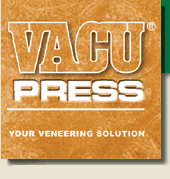Kevin Jenness

Posts: 13
Joined: 2007-12-04
 User Profile User Profile |
I am writing to ask for advice on repairing a conference table that has developed roughness on its surface.The table is 2"x48"x144", paperbacked quartersawn maple over a core of 1/2"mdf and 1" Plascore honeycomb, bonded with epoxy rolled onto both substrate and veneer and pressed in a vacuum bag. The finish is M.L.Campbell Enviromax.The paper/mdf bond seems fine, no hollow spots or lifting at the edges were found. There is widespread roughness in the finish and/or veneer.There is some ridging or uplift at the veneer seams in places, but a lot of roughness elsewhere, aligned with the long grain. The greatest amount of ridging is on the order of .001" to .002". There is a sunburst inlay in beech and cherry at the table's center that shows no problems despite its being made of thicker material than the surrounding veneer. There is no problem on the underside of the table. I noticed that the finish seemed to have been built up less on the bottom than the top, but saw no cupping or bowing. The table is part of a larger job including a 30"x80" coffee table of similar construction, two large curved workstations and several other cabinets, all clad in the same flitch laid up on paper backing. There are no similar problems in any of the other pieces. The project was built in the summer in a non climate controlled shop and is in a climate controlled office. I don't know the humidity level currently, but for sure it is lower than the shop at the time of construction. The main difference I can see between the table and the rest of the work is that it was laid up with epoxy rather than a pva glue, and it does get some direct sunlight through the day. I am leaning toward the idea that the finish is allowing sunlight to get through and affect the veneer,paper bond. It is possible that there is excess finish thickness causing cracking in the finish, but there definitely is movement in the veneer as well. I don't know the characteristics of the paper/veneer adhesive, though I have been told it is heat activated and comes to the fabricator already on the paper. The total thickness of the sheets is about.020", half veneer and half paper. I don't believe that the veneer leaves were glued edge to edge, but rather were taped, as the laidup panels from the same source had some tape residue in spots.
I'm leaning toward stripping the table, possibly laying on a washcoat of epoxy, and respraying with a more uv resistant finish. Perhaps we can get the client to keep the blinds down when the conference room is not in use.
Rebuilding the table is not an attractive option, but would be preferable to refinishing and failing to get a better result. I'm not sure I understand why this problem is happening, and that is crucial to any strategy for resolving it. Any comments or experience you have had would be most appreciated.
|






